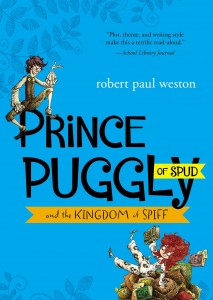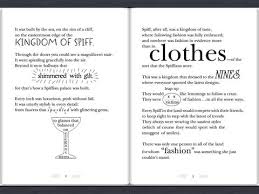 Why I Picked It Up: This was a classic case of “Sherry” and “Jessica” books. In preparation for our Head to Head session, we each needed a novel-in-verse to read and review. Jessica had already fallen in love with The Crossover, so I had to find my own novel-in-verse that was different enough to be competitive in our session. Prince Puggly caught my eye because the title is fun and silly, and then when I opened the book and began to flip through it, I was completely sold.
Why I Picked It Up: This was a classic case of “Sherry” and “Jessica” books. In preparation for our Head to Head session, we each needed a novel-in-verse to read and review. Jessica had already fallen in love with The Crossover, so I had to find my own novel-in-verse that was different enough to be competitive in our session. Prince Puggly caught my eye because the title is fun and silly, and then when I opened the book and began to flip through it, I was completely sold.
Why I Finished It: WORDS! I love words, and the author uses a lot of them! While poetry has never really been my “thing,” witty, clever writing and visual plays on words are right up my alley, and this book was so fun to read. I actually stopped a few times to read a verse or two out loud to my husband (who humored me with a chuckle even though he had no idea what was going on in the story). On the surface, it’s a very light tone/rhyme scheme (I kept thinking about a court jester as I read), but as you get into it, the topic is very deep and the vocabulary is amazing. I imagine it’s hard to rhyme for 200 pages, so you branch out a little more in your vocabulary.
It’s about two kingdoms, the Spiffs who epitomize all that is good and right about fashion, and the Spuds, who don’t. The Spuds are into loud, mismatched clothes – its more about comfort for them. Well, the king of Spiff is having a big fancy party, and the only problem is his daughter, who would rather read in her pajamas. She runs away after being humiliated by the sage of fashion, Miss Ruby La Rue. Meanwhile, the Spuds are looking for a new king after their old one ran away to be a hairdresser, and they find Puggly. Puggly doesn’t want to be a king, but being a prince sounds pretty good. As the reigning deity, he is invited to the Spiffian ball. He is also embarrassed by Miss Ruby at the party for his style, or lack thereof. As you can guess, the two meet up in the nearby forest, and they hatch a plan. In the end, everyone realizes that it’s not the clothes, but who you are, that really matters. The division between the two kingdoms, Spiff and Spud, brings up undertones of classics like Romeo and Juliet, The Outsiders, The Butter Battle Book, and The Sneetches. The “be yourself” message is very strong in this book as well, which is something that students can’t hear too many times.
Who I Would Give It To: The easy rhyming meter make it a quick read for upper elementary, but younger elementary students would also enjoy reading it, though they might need some help with some of the words. It would also make a great read-aloud, or mentor text for concrete poetry.
Integration Ideas
Theme/Guiding Questions
Identity
- How is my identity shaped by those around me?
- How do you form an identity that is true to yourself, even if it isn’t what the culture around you says you should be?
- When should an individual take a stand in opposition to an individual or larger group?
Relationships – Family/Friendship
- How are people transformed by their relationship with others?
- How do relationships (family or friends) play a role in shaping our values and beliefs?
Reading and Writing
This book would be a great introduction to theme poems, graphic elements of poetry, and concrete poetry.
Choose a page that is an example of concrete poetry and read it aloud to the students without them being able to see the page. Discuss what they are thinking and visualizing as you read. Have students make inferences and draw conclusion based on the reading. Then provide a visual of the page and reread the poem.
- How do the line and word positioning help interpret the text?
- Was it easier to visualize or did it change your visualization when you were able to see the text?
- Why did the author choose to use concrete poetry on this page?
Have students discuss the word placement on the page help with the meaning of the poem. In journals, have students write how the placement of words help the meaning of the poem. Then, use one of the following places in the story and have students add their own graphic elements to make the passage fit with the rest of the book:
- Description of the Shaman of Spud – 18
- Shaman’s answer to Puggly’s question – 64 (3rd stanza: “Next…”)
- Description of the party – 140
- Granny’s answer – 170 (4th stanza: “The old woman smiled…”)
- “A kingdom like this” – 194 (4th stanza)
ReadWriteThink also has a great activity for grades 3-5.
Technology Integration
Reading fluency is an important part of being a good reader, and it is especially important when reading poetry, where appropriate phrasing and expression can contribute to the meaning of the poem. It is a difficult skill to master, but using a fun poem like this can help students get the practice they need.
Have students choose a favorite page and take a picture of it with their device. Use the picture of the page as the background for an app like Show Me or EduCreations. Students can annotate the page however is helpful to them (identifying punctuation, circling phrases, etc.) then hit record, and read the page out loud. When they’re done recording, they can submit to you for review.
Example: http://www.showme.com/sh/?h=xPcqFgu







This is cool
This book sounds delightful, although it’s below grade level for my students. I look forward to reading it with my granddaughter.